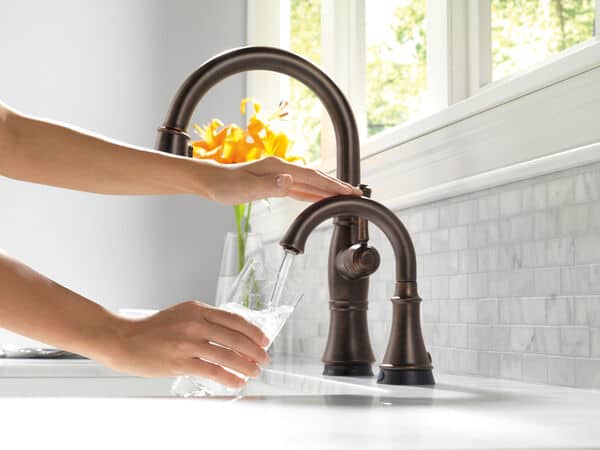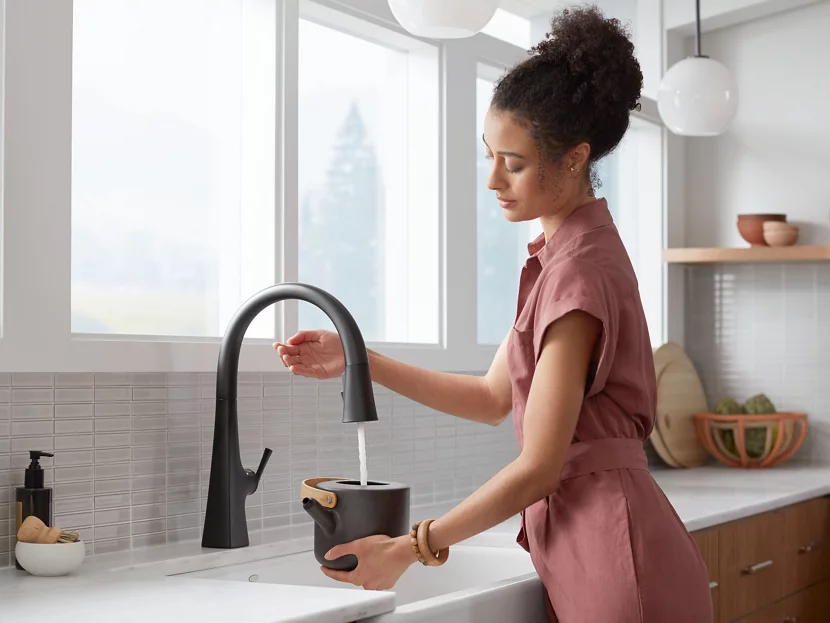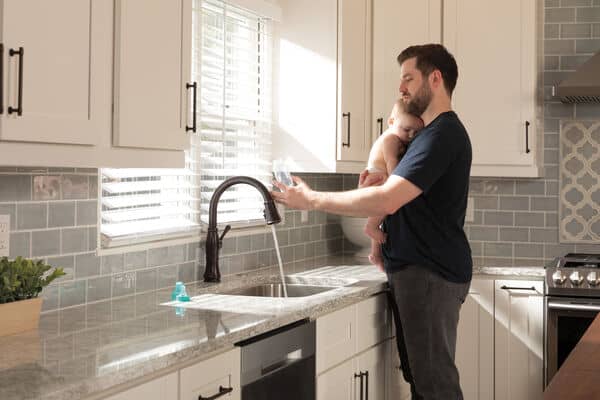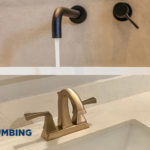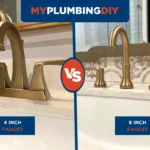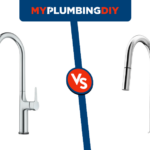This post may contain affiliate links. If you use these links to buy something we may earn a small commission. Thanks.
Picking a new faucet for your kitchen is a big decision. Whatever faucet you buy will last for 10-20 years and you’ll probably use it every day of your life.
Getting the right type of faucet makes a huge difference.
Today I’m doing a crazy deep comparison of touch vs touchless faucets. The names are similar, but they function very differently.
I’ll walk through the differences between touch and touchless faucets, their advantages and disadvantages, and which style will work best in your kitchen.
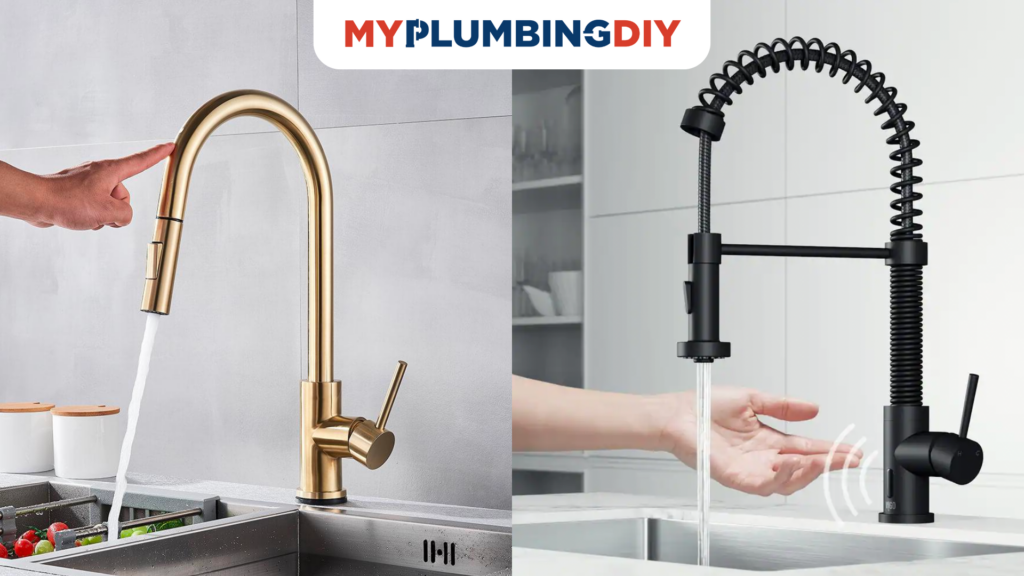
What is the Difference Between Touch and Touchless Faucets?
The difference between touch and touchless faucets is how they are turned on. Touch faucets are activated by physical contact such as tapping the faucet while touchless faucets are motion detected and will turn on if they detect movement near the faucet spout.
Touch and touchless faucets can be the same faucet brands, mounting type, hole arrangement, finish color, etc. They can be identical with the exception of how they are turned on.
Touchless faucets are definitely more popular for home use. Most of the top faucet brands have put a ton of R&D into creating a great selection of touchless faucets.
These are both unique types of kitchen faucets compared to the standard faucet that you turn on manually/normally.
If you just want to know the difference between touch and touchless faucets, that’s all you need! If you want a deeper dive on how each one works with the pros and cons, keep on reading.
How Do Touchless Kitchen Faucets Work?
Touchless kitchen faucets utilize infrared or ultrasonic technology that detects movement underneath the faucet. These are often called motion-detect faucets, but the technology is a bit different.
These sensors are usually placed on the faucet spout. When they detect movement in front of the sensor, the infrared light will bounce off your hand and back to the sensor. This triggers the faucet to turn on.
When you’re done, just wave your hand underneath and it will turn back off. Some touchless faucets will run for a set period of time and others will stay running until they detect motion again.
Touchless faucet are normally single handle, single hole faucets. You can still adjust the hot and cold water with the handle.
Most touchless faucets need a high arching design for the sensor to work so they are usually pull down faucets instead of pull out faucets.
If you really want to know how the technology works we’ve got you covered.
Deep Dive for the Tech-Geeks
Touchless faucets utilize either infrared or ultrasonic technology to detect movement that opens the faucet’s solenoid valves.
Infrared: Infrared faucets have a small infrared light being aimed underneath the faucet. You won’t be able to see this light, but when you move your hand through the light it will reflect the light back to the faucet’s sensor, telling the faucet to turn on or off.
Ultrasonic: Ultrasonic touchless faucets have a sensor at the base of the faucet. They don’t use reflected light to detect movement, but instead use a 3D ultrasonic field that can’t be detected with the human eye. When this ultrasonic field is disturbed by movement like your hand the sensor will turn on.
For either technology method, once the sensor is triggered by movement, it will activate a solenoid valve which is a device that actually opens or closes the faucet valves. Once the valve opens, water will flow through the faucet.
Pros and Cons of Touchless Faucets
Pros
- Showstopping experience – Touchless faucets are a truly high-end feature you can add to your home kitchen. This will instantly make your kitchen stand out. If you want to impress people or increase your home’s resale value, go touchless.
- Most convenient – Touchless faucets are the most convenient faucet to use. All you have to do is wave your hand, bowl, plate, or anything else under the faucet and it’ll turn on.
- Cleanest faucet type – Because you almost never have to touch this faucet it will stay cleaner than any other type of faucet.
Cons
- Cost – Touchless faucets are the most technologically advanced and can require more advanced installation. This makes them almost twice as expensive as standard faucets.
- Can have issues turning on – If your faucet is battery powered then you might have issues turning the faucet on. You almost might accidentally turn the faucet on if you’re just putting dishes in the sink.
- Requires a power source – Touchless faucets must have a power source to operate. Some faucets are battery powered while others can be plugged into an outlet.
How Do Touch Faucets Work?
Touch faucets have two sensors that are connected by a thin piece of wire that helps the faucet become a conductor for electricity.
You may not know this but our bodies actually store electrical energy (capacitance).
The faucet sensors are incredibly sensitive to changes in electrical current and even the slightest human touch can turn them on. When you touch the faucet, the static electricity will send an electrical charge, which activates the sensor and turns on the faucet.
Pros and Cons of Touch Faucets
Pros
- Easy to use – Touch faucets are incredibly easy to use! Simply give them a tap with your finger, hand, elbow, or any other body part. If your hands are full of food or dishes, you can easily give these a nudge to turn them on.
- Highly accessible for all people – Some people may struggle to use motion-detected faucets. Touch faucets are simple for kids or elderly people to use.
- Conserves water – Normal faucets will often run longer than needed because you aren’t able to turn them off with the handle. If you’re in the middle of cooking, all you have to do is give your touch faucet a tap and it’ll turn off, saving you water.
- Less cleaning needed – Touch faucets are much cleaner than regular faucets. All you have to do is clean the faucet spout every once in a while.
Cons
- Difficult to install – If your touch faucet requires an electric outlet then it may be more difficult to install.
- Cost – Touch faucets have more technology built in which makes them quite a bit more than a standard faucet.
- Requires a power source – Touch faucets require a power source of some kind. Some may be battery powered while others are plugged into an outlet.
Common Questions About Touch and Touchless Kitchen Faucets
Touchless faucets are better than touch faucets because they are sleeker, cleaner, and a higher end feature for home kitchens.
Touch activated faucets are worth it if you can afford them! A higher end faucet is an easy way to level up your home kitchen design, functionality, and future resale value.
Touch faucets are a great way to make your kitchen more unique by having a faucet that is easily touch activated.
If your touch faucet is battery powered then it will still run without power as long as the batteries don’t die. If your faucet is plugged into an electrical outlet then it won’t turn on while the power is out.
If your touchless faucet runs on batteries, you will have to replace them every 1-2 years depending on how much you use it. If your faucet is hardwired to plug into an outlet then the faucet can easily last for 10-20 years as long as you maintain it and replace parts as needed.
Final Thoughts: Is a Touch or Touchless Faucet Best for your Kitchen?
We’re big fans of touchless faucets because they look great in most kitchens and have better functionality. Touch faucets are cool, but not as unique as touchless and they aren’t that much better than a regular faucet that you turn on normally.
For us, it’s an easy choice. Pick a touchless faucet every day of the week. It’s the easiest way to level up your kitchen.
I hope our touch vs touchless faucets comparison helped you decide which one is right for you!
If you decide that a higher tech faucet is out of your price range but you still want something high end, check out a bridge faucet or a pre-rinse kitchen faucet.
